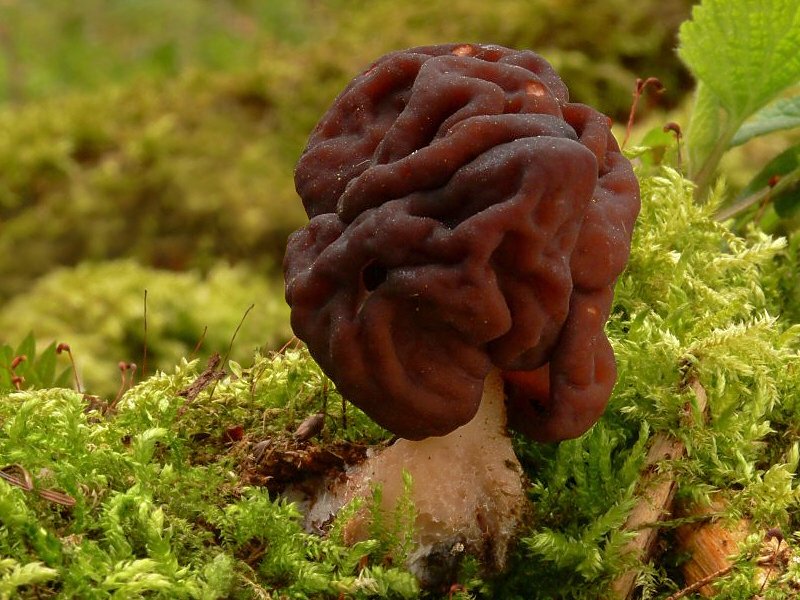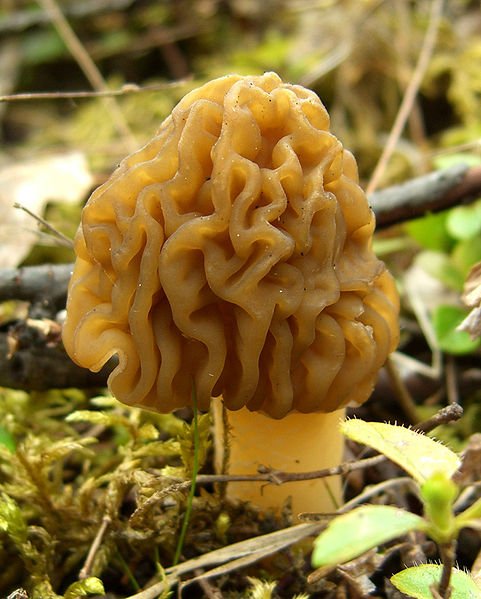
These posts are not for foraging. They are intended for entertainment and educational purposes only. These posts are not a field guide nor comprehensive in any way - their accuracy is not assured in any way. Do not eat wild mushrooms unless you are a professional or have a wealth of personal experience with a specific species. Do not make any foraging decisions based on these posts. To do so could be dangerous or life threatening.
What is a morel? This is up for some debate. Certainly there is an archetypal "morel" with an archetypal look. I've chosen to highlight Morchella esculenta and americana/esculentariae because they fit that description. No doubt, even the less mycologically incined of readers has seen something like the mushrooms pictured above.
But the actual species of a given morel mushroom can be notoriously difficult to discern. Indeed, even finding a specific species of morel to highlight for this post proved fairly difficult, as certain species don't even have consistent naming conventions. M. americana comes up as americana someplaces while Michael Kuo refers to is as M.esculentariae. Meanwhile Kuo does not directly write about M.esculenta, although wikipedia has a long article on the species. It isn't even clear to me now whether all three of these names refer to the same species!

Beyond the inter-special strife, there is also the problem of lookalikes. Some mushrooms look very similar to "true morels" but don't even fall in the same genus. Last time we dealt with the oft-poisonous G.esculenta. But consider also Verpa bohemica to the right.

V.bohemica is like the child of the brainy looking G.esculenta and a genuine morel - V.bohemica's cap has brain-like folds instead of the true morel's pits, while maintaining the overall look and shape of a true morel.
Even the well versed mushroom hunter could be excused for mistaking V. bohemica for a true morel species. And yet, V.bohemica has been known to cause poisonings similar to G.esculenta and may produce small amounts of a toxin similar to gyromitrin.

Even a "true morel" may still come in a variety of shapes, colors and sizes - hence the difficulty in species identification. Let's focus on Morchella esculenta.
When I think morels, this is where my mind goes. A small to medium sized mushroom - a cap consistently pitted, colored in browns and yellows - with a cream white stem. Cut this mushroom in half and the head should be hollow, the lower edges of the cap connected to the stem. A spore print is possible, but difficult, as the spores emanate from the pits in the cap.
https://upload.wikimedia.org/wikipedia/commons/thumb/7/77/Morchella_esculenta_-DE-TH-2013-05-02-02.JPG/800px-Morchella_esculenta-DE-TH-2013-05-02-_02.JPG
Morels of all kinds pop up in all kinds of environments, over a range of months depending on the locality - anywhere from February to July. In North America you can find them in coniferous and deciduous forests - there is even whispered word of morels being found in NYC parks by the local mycological society.

Many morels share similar macroscopic and ecological traits and often different species of morel will be found in the same place but at different times of the year. If you're interested in ID'ing a morel down to an exact species, you will be in for a long, detailed search that will likely require a number of specimens at different levels of maturity, in addition to a keen sense of observation. So keen, I'm not even certain I possess it.
Poisonous Morels?

Believe it or not there is anecdotal mention from several sources that even the morel contains a toxic substance in small quantities - a chemical called hydrazine. And in case you were wondering, unbelievably, YES, Hydrazine is also a form of rocket fuel.
I didn't know that morels produced this substance - nor can I say how much is produced. The same sources claim that hydrazine is heat sensitive at relatively low temperatures and that cooking the morels - whether by frying or boiling - eliminates the toxin. I have no idea..
https://upload.wikimedia.org/wikipedia/commons/thumb/2/21/Morchella_esculenta_-DE-TH-2013-05-01-02.JPG/800px-Morchella_esculenta-DE-TH-2013-05-01-_02.JPG
I suppose my point, overall, is that despite its fame, the Morchella genus remains elusive and controversial. There are still many unanswered questions regarding the Genus as a whole, primarily:
- The exact number of species - currently a wide range of estimates exist and the extent of genetic testing has not been comprehensive.
- The exact ecology of the various species, even those well identified. Morels seem to live in both saprobic and mycorhizzal ecologies - perhaps even both for the same mushroom.' The difficulty in identifying the mushrooms ecology has made cultivation impossible up to this point and makes the global morel supply reliant on wild hunters.
- Even the exact naming conventions for certain species is in a state of uncertainty.
Macroscopic Features – Based on M. americana/esculentoides
- Cap/Flesh = Anywhere from 5cm to 22cm depending on the species. 1.5 – 6 cm wide. What your looking for broadly will be a cone shaped cap, although some will be shaped differently. You should look for pits rather than ridges, although sometimes its very hard to tell the difference. Colors can cover a large range – light through dark browns, shades of yellow, shades of gray. Some species will have a different color on the external portion of the pits and a darker color inside, some sometimes the opposite. Cut the cap open and it should be hollow on the inside.
- Spore surface = Spores created inside the pits of the cap. Difficult to get a spore print but should be white or yellow.
- Stem ("stipe") = 2-12cm tall, 1.5-10cm wide. Usually lighter than the cap – white, yellowish or brownish – usually hollow when bifurcated. Importantly, it should be attached to the cap of the mushroom, at least partially, at the base. If not it may be V.bohemica.
- Spore Print = White to yellowish
- Ecology ("How it grows.") = Also weird – and not entirely clear – saprobic sometimes and sometimes mycorrhizal depending on either the state of the mushroom or, so to speak, the phase of the moon. It isn’t entirely understood – and if it was, people would grow them. Sometimes they grow alone, sometimes in small or large groups. If mycorrhizal, then probably with hardwoods.
- Distribution = East of the rocky mountains, up into Canada – March through June – Obviously a wide variety of other Morchella species worldwide
- Other Traits = Two lookalikes in V.bohemica and G.esculenta – both poisonous. Morels may contain toxic hydrazine.
Disclaimer
The only 100% way to avoid being hurt by a wild mushroom is not to eat a wild mushroom. These posts are not field guides - they are intended for the mycology enthusiast, not the forager. If you want to forage mushrooms there are professional resources available to that end online as well as local mycological societies all over the world which you should connect to for guidance.
Have a Mushroom you want help identifying? - leave a message on the Steemit Mycology discord channel.
https://discord.gg/JJgEW2y
For The Online Mycokey program look Here
For A Crash Course On How To Identify A Mushroom Read The Amatuer Mycologist #3
For a Glossary Of Relevant Mycological Terms, Micheal Kuo's Website Provides
Information Sources
http://www.first-nature.com/fungi/morchella-esculenta.php
http://powo.science.kew.org/taxon/urn:lsid:indexfungorum.org:names:247978
https://en.wikipedia.org/wiki/Morchella
https://en.wikipedia.org/wiki/Morchella_esculenta
http://bioweb.uwlax.edu/bio203/s2012/long_brad/
http://www.mushroomexpert.com/morchella_esculentoides.html
http://www.midwestmycology.org/Mushrooms/Species%20listed/Morel%20species.html
http://www.mycobank.org/MB/563915
https://en.wikipedia.org/wiki/Morchella_americana
https://en.wikipedia.org/wiki/Hydrazine
Photo Sources
[4]By Jason Hollinger Mushroom Observer CC BY-SA 3.0 via Wikimedia Commons
[6]TOMMES-WIKI own work - CC BY-SA 3.0]
[7]By J7u Own work CC BY-SA 3.0, via Wikimedia Commons
[8]By Ben Mills Own work Public domain, via Wikimedia Commons
[9]By TOMMES-WIKI Own work CC BY-SA 3.0 via Wikimedia Commons
.
..
